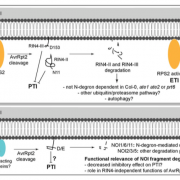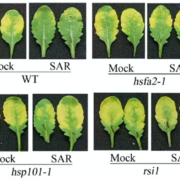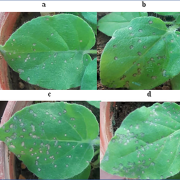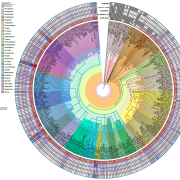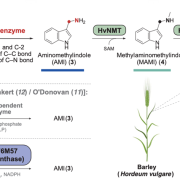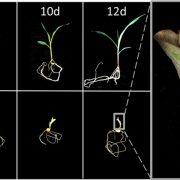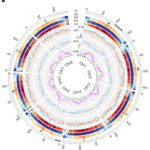Immature leaves are the dominant volatile-sensing organs of maize
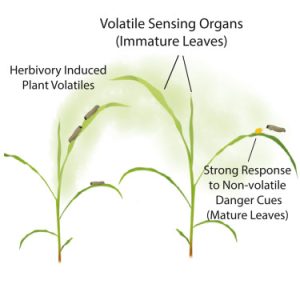 It’s well established that damaged plant tissues emit volatile compounds that bolster defense responses in nearby plants, but how those neighbors sense these compounds has remained obscure. This new work by Wang et al. reveals some important clues. First, as the title indicates, immature leaves are much more responsive to damage-associated volatiles (the authors specifically use (Z)-3-hexenyl acetate, HAC, as a proxy in many of their studies). This is a volatile-specific developmental effect; older leaves remain sensitive and responsive to non-volatile defense cues such as the peptide ZmPep3. The authors also investigated factors that might affect volatile perception, looking at both stomatal aperture and the epidermal cuticle as possible variables. Interestingly, changing neither appears to affect volatile perception. The authors speculate that factors involved in HAC perception or early stages of the signal transduction pathway might be preferentially expressed in young leaves, and suggest that, as young leaves are present at the outer periphery, the plant might benefit from focusing its perception in these regions (an analogy is drawn to the heightened environmental sensitivity of the root tip). Or, the plant might preferentially protect its young leaves by providing them with heightened sensitivity. Finally, the authors observe that knowing about this developmental pattern of sensitivity can provide an opportunity to finally identify the specific receptors for these volatiles. (Summary by Mary Williams @PlantTeaching) Curr. Biol. 10.1016/j.cub.2023.07.045
It’s well established that damaged plant tissues emit volatile compounds that bolster defense responses in nearby plants, but how those neighbors sense these compounds has remained obscure. This new work by Wang et al. reveals some important clues. First, as the title indicates, immature leaves are much more responsive to damage-associated volatiles (the authors specifically use (Z)-3-hexenyl acetate, HAC, as a proxy in many of their studies). This is a volatile-specific developmental effect; older leaves remain sensitive and responsive to non-volatile defense cues such as the peptide ZmPep3. The authors also investigated factors that might affect volatile perception, looking at both stomatal aperture and the epidermal cuticle as possible variables. Interestingly, changing neither appears to affect volatile perception. The authors speculate that factors involved in HAC perception or early stages of the signal transduction pathway might be preferentially expressed in young leaves, and suggest that, as young leaves are present at the outer periphery, the plant might benefit from focusing its perception in these regions (an analogy is drawn to the heightened environmental sensitivity of the root tip). Or, the plant might preferentially protect its young leaves by providing them with heightened sensitivity. Finally, the authors observe that knowing about this developmental pattern of sensitivity can provide an opportunity to finally identify the specific receptors for these volatiles. (Summary by Mary Williams @PlantTeaching) Curr. Biol. 10.1016/j.cub.2023.07.045


